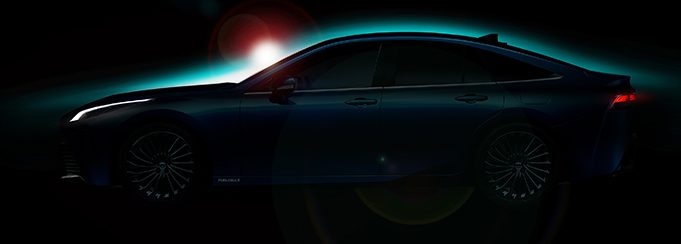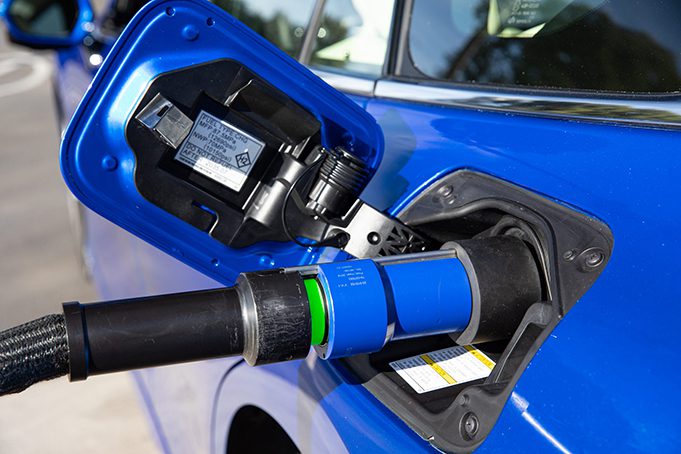
SAN DIEGO — I spent the past week with one of the strangest cars I’ve ever driven.
It’s the hydrogen-powered Toyota Mirai, and it might be the future, or it might be a weird research project — it’s just too soon to tell.
As a car, the Mirai is lovely. It’s built on the same platform as the Lexus LS, and it’s comfortable, roomy, quiet, and luxurious. And with a $67,420 price tag, that all makes sense.
The exterior, especially in the Hydro Blue my tester had, is sharp, with pleasing angles and a design that carries the car’s significant bulk well. It’s not a small vehicle, but it never seemed ungainly.
Inside it’s typical Toyota, with easy-to-reach controls, cupholders and a wireless phone charger in the center console, and lots of safety and convenience features like adaptive cruise control and ventilated and heated seats.
So, you might think it’s just a large luxury sedan and leave it at that. Except it’s not if you look under the hood.
That’s because this car is powered by hydrogen. There are three carbon-fiber-reinforced tanks in the Mirai that hold a total of 11 pounds of hydrogen under 10,000 PSI of pressure. One is in the center tunnel between the passengers (which is why the center console is so massive), another below the rear seat, and a third beneath the battery behind the rear seats.
I heard many Hindenburg jokes during my week with the Mirai, but rest assured that the Mirai’s hydrogen tanks can withstand gunfire (Toyota tested them), so I wasn’t too worried. Basically, if you’re in a crash severe enough to have an impact on the hydrogen tanks, those tanks are probably the least of your worries.
Driving the Mirai is an awful lot like driving any other Toyota hybrid. It has the same odd gear knob that a Prius has, and at low speeds, it’s literally the same experience. A large lithium-ion battery is located in the rear and provides power at low speeds, helps with efficiency by generating electricity during braking, and gives the car a small added boost of power during acceleration.
Sitting behind the wheel, you would barely notice anything was different except for the weird, artificial “whoosh” noise that Toyota pipes in through the stereo, so you get some kind of audible feedback of what’s going on under the hood.
And now we get to the weird stuff.
A hydrogen-powered car works as an electric car: a large battery and electric motors to turn the wheels. Except where a battery-electric vehicle (or BEV, as some in the industry like to call it) uses a large battery charged from the electric grid to power the motors, a hydrogen car uses something called a fuel cell to generate electricity.

It’s still “green” and silent, but your energy comes from a chemical reaction in the fuel cell “stack.” Hydrogen from the tank combines with oxygen in the air to produce electrical current and water. The water drips out of a small pipe beneath the car and is the only byproduct of the process.
Hydrogen molecules pass through an anode where they’re split into electrons and protons. Electrons go off to a circuit to generate electrical current, while protons go through an electrolyte membrane to a cathode where they meet up with oxygen and the split electrons and turn into water molecules.
Complicated? Wildly. But the net effect is that you can “fill up” an electric car with hydrogen in just a few minutes, rather than waiting much longer to charge a battery in an electric vehicle. In a way, it’s all the convenience of a gas-powered car with the environmental friendliness (and clean air) of an EV.
Of course, there’s a catch. Actually, several.
First, hydrogen fuel cells are expensive. They use lots of platinum, titanium, and carbon fiber between the fuel cell and hydrogen storage. Toyota sells this Mirai for $66,000 before government tax incentives knock more than $10,000 off the price.
And Toyota is probably losing money on every single one they sell.
That’s partially because they also include a $15,000 prepaid debit card to cover the cost of hydrogen. Toyota also throws in 21 days of free car loans because hydrogen is extremely hard to find.
There is a single hydrogen filling station in San Diego County, and the rest are primarily located in Orange County or the Bay Area in California. A Mirai owner told me that when the San Diego filling station was offline for a week earlier this year, Toyota gave all San Diego Mirai owners loaner cars because they couldn’t fill up.
There are some new hydrogen stations in the works, but nothing close to a nationwide network. The infrastructure just isn’t there yet. Many companies are investing in hydrogen technology, and Honda, Toyota, and Hyundai all sell hydrogen cars in California — but we’re years, or likely decades away from it going mainstream.
And so, my week in the Mirai is a bit of a taste of the future. Costs need to go down, and the number of filling stations needs to go up, and there’s no guarantee that either of those things will happen in a timely manner.
But I drove a car that emits only water, makes no noise, and leaves the air cleaner than it found it thanks to a bunch of air filters. Is the Mirai part of our hydrogen-powered future? I don’t know, but it sounds pretty good to me.




